Recessed lighting, often referred to as can lights or downlights, is a popular choice for kitchens due to its sleek, unobtrusive design and effective illumination. These lights are installed into hollow openings in the ceiling, creating a streamlined look that enhances the kitchen’s aesthetics while providing ample light for various tasks. The appeal of recessed lighting lies in its ability to blend seamlessly with the ceiling, making it a versatile option for any kitchen style, from contemporary to traditional.
One of the primary advantages of recessed lighting in the kitchen is its ability to provide uniform and focused illumination. Unlike pendant lights or chandeliers, which can create shadows and uneven lighting, recessed lights distribute light evenly across the entire kitchen. This is particularly beneficial for kitchens with large or irregularly shaped layouts, as it ensures that every corner of the room is adequately lit. Proper lighting is essential in the kitchen, where tasks such as chopping, cooking, and cleaning require clear visibility.

Recessed lighting can be strategically placed to highlight specific areas of the kitchen. For example, lights can be installed directly above the countertops, sink, and stove to provide task lighting where it is needed most. This targeted illumination not only enhances functionality but also adds a layer of safety by reducing the risk of accidents during food preparation. Additionally, recessed lights can be used to accentuate architectural features, such as a kitchen island or a decorative backsplash, drawing attention to these focal points.
The versatility of recessed lighting extends to its compatibility with various lighting technologies. LED recessed lights, for instance, are an energy-efficient option that can significantly reduce electricity consumption and lower utility bills. LEDs have a longer lifespan compared to traditional incandescent bulbs, which means less frequent replacements and maintenance. Moreover, LED lights come in a range of color temperatures, from warm to cool, allowing homeowners to create the desired ambiance in their kitchen.

Another benefit of recessed lighting is its ability to create a clean and clutter-free ceiling. Unlike pendant lights or chandeliers, which hang down and can visually dominate the space, recessed lights are flush with the ceiling, making the kitchen feel more open and spacious. This is especially advantageous in kitchens with low ceilings, where hanging fixtures might make the room feel cramped. The unobtrusive nature of recessed lighting allows other design elements, such as cabinetry and countertops, to take center stage.
Recessed lighting can be customized to suit individual preferences and needs. The trim and housing of the lights come in various styles and finishes, allowing homeowners to match the lighting fixtures to their kitchen decor. For example, a sleek, chrome trim might complement a modern kitchen, while a white or bronze trim could be better suited for a traditional space. Additionally, the size and type of the light bulbs can be selected based on the desired intensity and spread of light.

Installing recessed lighting in a kitchen requires careful planning and consideration of the overall layout and design. It is important to ensure that the lights are spaced evenly and at the correct distance from the walls and other fixtures. An optimal spacing guideline is to place lights approximately 4 to 6 feet apart, depending on the size of the kitchen and the desired brightness. Placing the lights too close together can create an overly bright and harsh environment while spacing them too far apart can result in insufficient illumination.
One of the challenges of recessed lighting is avoiding glare and ensuring that the light is directed where it is needed. To address this, homeowners can choose from various types of trims, such as baffle, reflector, or adjustable trims. Baffle trims, with their ribbed interior, help to reduce glare and soften the light, making them ideal for general lighting. Reflector trims, on the other hand, enhance the brightness and are suitable for task lighting. Adjustable trims allow the light to be directed at specific angles, providing flexibility in lighting design.
Dimmer switches are an excellent addition to recessed lighting systems, offering control over the brightness and ambiance of the kitchen. With dimmable recessed lights, homeowners can adjust the light levels to suit different activities and moods. For instance, bright lighting might be needed for cooking and cleaning, while a softer, dimmed light could create a cozy atmosphere for dining or entertaining. Dimmer switches also contribute to energy savings by reducing the overall power consumption of the lights.

In addition to the functional benefits, recessed lighting can enhance the aesthetic appeal of a kitchen. When installed correctly, these lights create a sense of depth and dimension, highlighting the textures and finishes of the kitchen surfaces. For example, recessed lights can accentuate the gleam of polished granite countertops, the sheen of stainless steel appliances, or the intricate details of custom cabinetry. The interplay of light and shadow adds visual interest and sophistication to the kitchen design.
Recessed lighting is particularly effective in open-concept kitchens, where the kitchen space flows into the dining or living areas. By installing recessed lights in both the kitchen and adjacent areas, homeowners can create a cohesive and unified lighting scheme. This seamless transition of lighting helps to define the different zones within the open-concept space while maintaining a harmonious overall look. Recessed lights can also be paired with other types of lighting, such as under-cabinet lights or pendant lights, to create layers of illumination and enhance the functionality and ambiance of the kitchen.
When considering recessed lighting for a kitchen, it is important to take into account the type of ceiling. Standard recessed lights are suitable for flat ceilings, but sloped or vaulted ceilings may require specialized housings that can be adjusted to fit the angle of the ceiling. In some cases, remodeling or retrofitting recessed lights might be necessary, especially in older homes where the existing electrical wiring and insulation might not be compatible with new lighting fixtures.

Proper insulation and ventilation are critical when installing recessed lights, particularly in kitchens where heat and moisture levels can be high. Insulation contact (IC) rated housings are designed to prevent overheating and can be safely installed in contact with insulation materials. Non-IC rated housings, on the other hand, require a clearance space around the light fixture to dissipate heat. Ensuring that the recessed lights are properly insulated and ventilated helps to maintain the safety and efficiency of the lighting system.
Another consideration is the type of bulb used in recessed lighting. While LED bulbs are a popular choice for their energy efficiency and long lifespan, other options include halogen and compact fluorescent bulbs. Halogen bulbs provide a bright, white light that is ideal for task lighting, but they can generate more heat compared to LEDs. Compact fluorescent bulbs are energy-efficient and produce a soft, diffused light, but they contain small amounts of mercury and require proper disposal. Selecting the right type of bulb depends on the desired lighting effect and energy considerations.
The installation of recessed lighting in a kitchen is a project that can be undertaken by experienced DIYers, but it often requires the expertise of a professional electrician. Proper installation involves ensuring that the electrical wiring is up to code, the lights are securely mounted, and the ceiling is properly patched and painted after the lights are installed. Hiring a professional can ensure that the installation is done safely and correctly, minimizing the risk of electrical issues and ensuring that the lighting system performs optimally.
Recessed lighting offers a multitude of benefits for kitchen design, from providing uniform and focused illumination to enhancing the aesthetic appeal of the space. Its versatility and unobtrusive nature make it a suitable choice for various kitchen styles and layouts. By carefully planning the placement, selecting the appropriate trims and bulbs, and considering factors such as insulation and ventilation, homeowners can create a well-lit and visually appealing kitchen that meets their functional and aesthetic needs.

Common Mistakes to Avoid
One common mistake when installing recessed lighting in a kitchen is inadequate planning of the layout. Failing to consider the spacing and placement of the lights can result in uneven lighting and dark spots. It’s essential to create a detailed lighting plan that takes into account the size and shape of the kitchen, as well as the specific areas that need illumination, such as countertops and work zones.
Overloading the kitchen with too many recessed lights is another common error. While it might seem beneficial to have as much light as possible, too many lights can create a harsh and uninviting atmosphere. It’s important to strike a balance by installing enough lights to provide adequate illumination without overwhelming the space. Using dimmer switches can help adjust the light levels to suit different activities.
Choosing the wrong type of trim can affect the functionality and appearance of recessed lighting. For example, using reflector trims in areas where glare reduction is needed can create uncomfortable lighting conditions. It’s crucial to select the appropriate trim for each location, whether it’s baffle trims for general lighting, reflector trims for task lighting, or adjustable trims for directional lighting.
:max_bytes(150000):strip_icc()/GettyImages-Perry-Mastrovito-56a27fbe5f9b58b7d0cb598d.jpg)
Neglecting to consider the ceiling type and insulation requirements can lead to safety issues and inefficient lighting. Using non-IC rated housings in contact with insulation can cause overheating, while improper ventilation can reduce the lifespan of the lights. Ensuring that the recessed lights are compatible with the ceiling structure and properly insulated is vital for a safe and effective lighting system.
Failing to integrate recessed lighting with the overall kitchen design can result in a disjointed look. The lighting fixtures should complement the kitchen’s style and color scheme, creating a cohesive and harmonious appearance. Matching the trim and finish of the recessed lights with other elements, such as cabinet hardware and appliances, can enhance the overall aesthetic.
Attempting to install recessed lighting without professional help can lead to electrical issues and subpar results. While experienced DIYers might handle the installation, it’s often best to hire a professional electrician to ensure that the wiring is up to code, the lights are securely installed, and the ceiling is properly finished. Professional installation can save time, prevent costly mistakes, and ensure the lighting system functions optimally.

What are the benefits of recessed lighting in the kitchen?
Recessed lighting offers several benefits for the kitchen, including uniform and focused illumination, a clean and uncluttered ceiling, and enhanced functionality and aesthetics. By providing even lighting across the entire kitchen, recessed lights improve visibility for cooking and food preparation tasks. Their unobtrusive design makes the kitchen feel more open and spacious, while the ability to customize the lighting placement and trim allows for targeted illumination and accent lighting. Additionally, recessed lights can be paired with dimmer switches for adjustable brightness, contributing to energy savings and creating the desired ambiance.
How do I plan the layout for recessed lighting in my kitchen?
Planning the layout for recessed lighting involves careful consideration of the kitchen’s size, shape, and specific lighting needs. Start by identifying the key areas that require illumination, such as countertops, the sink, and the stove. Create a detailed lighting plan that spaces the lights evenly, typically 4 to 6 feet apart, to ensure uniform coverage. Consider using different types of trims for various locations, such as baffle trims for general lighting and adjustable trims for task lighting. Consulting with a lighting designer or professional electrician can help create an effective and aesthetically pleasing lighting plan.
What types of bulbs are best for recessed kitchen lighting?
LED bulbs are a popular choice for recessed kitchen lighting due to their energy efficiency, long lifespan, and range of color temperatures. LEDs provide bright, clear light with minimal heat output, making them ideal for task lighting and general illumination. Halogen bulbs are another option, offering a bright, white light that enhances visibility but generates more heat than LEDs. Compact fluorescent bulbs are energy-efficient and produce a soft, diffused light, but they contain small amounts of mercury and require proper disposal. Selecting the right type of bulb depends on the desired lighting effect, energy considerations, and compatibility with the recessed light fixtures.

How do I maintain and care for recessed lighting in my kitchen?
Maintaining recessed lighting involves regular cleaning and periodic checks to ensure the fixtures are functioning correctly. Clean the trim and bulbs with a soft, damp cloth to remove dust and grime, taking care not to use abrasive cleaners that could damage the surfaces. Check the bulbs periodically and replace them as needed to maintain optimal brightness. If your recessed lights have dimmer switches, ensure they are compatible with the type of bulbs you are using to prevent flickering or reduced lifespan. Regularly inspect the insulation and ventilation around the fixtures to ensure they are not overheating and are properly installed.
Can recessed lighting be installed in all types of ceilings?
Recessed lighting can be installed in most types of ceilings, including flat, sloped, and vaulted ceilings, but it requires the appropriate housing and trim. Standard housings are suitable for flat ceilings, while sloped ceiling housings are designed to fit angled surfaces. Remodeling or retrofitting housings may be necessary for older homes or ceilings with existing electrical wiring and insulation. It’s important to use IC-rated housings for ceilings with insulation contact to prevent overheating. Consulting with a professional electrician can help determine the best type of recessed lighting for your specific ceiling type and ensure proper installation.
What are the common mistakes to avoid when installing recessed lighting in the kitchen?
Common mistakes to avoid when installing recessed lighting include inadequate planning of the layout, overloading the kitchen with too many lights, choosing the wrong type of trim, neglecting insulation and ventilation requirements, failing to integrate the lighting with the overall kitchen design, and attempting a DIY installation without professional help. Proper planning ensures that the lights are spaced correctly and provide uniform illumination. Selecting the appropriate trim and ensuring proper insulation and ventilation prevent safety issues and enhance functionality. Integrating the lighting with the kitchen’s style creates a cohesive look, and hiring a professional electrician ensures safe and efficient installation.

Related Posts:
- Dark Kitchen Cabinets With Light Backsplash
- Modern Industrial Kitchen Lighting
- Lowes Led Kitchen Ceiling Lights
- Light Fixtures Above Kitchen Table
- Kitchen Under Cabinet Lighting Tubes
- Multi Light Pendants Kitchen
- Shaker Kitchen Lighting
- Kitchen Taps With Led Lights Australia
- Creative Kitchen Lighting
- Kitchen Paint Color Ideas With Light Oak Cabinets